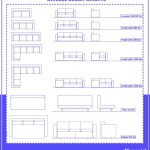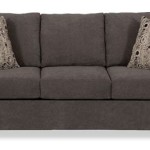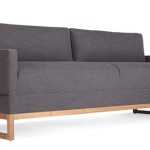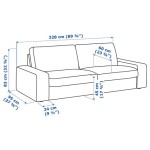How to Raise Sofa Height: A Comprehensive Guide
The height of a sofa significantly impacts both its aesthetic appeal and its ergonomic comfort. A sofa that is too low can be difficult to get in and out of, particularly for individuals with mobility issues or for taller users. Conversely, a sofa that is too high may appear disproportionate in a room and create an awkward seating posture. Raising the height of a sofa is a relatively straightforward project that can address these issues, making the furniture more accessible and visually harmonious within the living space. This article details various methods for increasing sofa height, providing practical guidance and considerations for each approach.
Understanding the Need for Increased Sofa Height
Several factors contribute to the decision to elevate a sofa. Ergonomics tops the list for many. A lower sofa often forces users to bend excessively when sitting or standing, potentially straining the back and knees. Raising the sofa provides a more upright seating position, improving posture and reducing discomfort. Aging furniture can also sag over time, resulting in a lower seating surface. This can be rectified by not only addressing the internal sagging but also by physically raising the sofa's overall height. Moreover, adapting the sofa to match the height of existing furniture within a room, such as coffee tables or side tables, can create a more cohesive and functional layout. Finally, increasing a sofa's height can transform its visual presence, making it appear more substantial or contemporary within the decor.
Methods for Elevating a Sofa’s Height
There are several practical approaches to increasing the height of a sofa, each with its own advantages and considerations. The most common methods involve adding legs or risers, replacing existing legs with taller ones, or utilizing a combination of both. Understanding the structural integrity of the sofa and the existing leg attachment mechanisms is crucial before proceeding with any of these methods.
Adding Sofa Legs or Risers
This method involves attaching new legs or risers to the existing sofa frame. It is a relatively simple and cost-effective solution, particularly for sofas with readily accessible attachment points. Before attaching any new legs, the material of the sofa’s frame and existing legs should be considered. The type of wood (hardwood vs. softwood), the presence of metal components, and the method of attachment (screws, bolts, adhesives) will all influence the choice of new components and the tools required for installation. Ensure the new legs or risers are of sufficient strength and stability to support the sofa's weight and the weight of its occupants. Weight capacity is a critical factor to consider, especially if the sofa is frequently used by multiple individuals or if it is a heavier model.
To begin, the sofa must be carefully lifted to provide access to the underside of the frame. Protecting the floor with a drop cloth or padding is highly recommended. Locate the existing leg attachment points or identify suitable areas on the frame where new legs can be securely mounted. Use a stud finder to verify there are no pipes or electrical wiring that could be damaged during the installation process. Once the location has been determined, pre-drill pilot holes to prevent the wood from splitting when screws are inserted. Select screws that are appropriately sized for the thickness of the frame and long enough to provide a secure hold without protruding through the top surface. Apply wood glue to the surfaces being joined for added strength and stability. After attaching the new legs or risers, allow the glue to dry completely before placing the sofa back in its upright position. Test the stability of the sofa by applying weight to different areas to ensure the legs are securely fastened and that the sofa sits evenly on the floor.
Replacing Existing Sofa Legs
Replacing existing sofa legs with taller ones offers a more refined and integrated solution for raising the sofa’s height. This approach requires careful selection of replacement legs that are compatible with the existing attachment mechanisms and that complement the sofa’s style. The first step is to remove the existing legs, if possible. Many sofas use threaded inserts for leg attachment, allowing the legs to be simply screwed in or out. If the legs are attached with bolts or screws, carefully remove them, taking note of their size and placement for reassembly. Once the existing legs have been removed, measure the diameter and thread type of the attachment points to ensure compatibility with the replacement legs. Replacement legs are available in a wide variety of styles, materials, and heights, from sleek, modern metal legs to classic, turned wood legs. Choose legs that not only meet the desired height increase but also enhance the overall aesthetic of the sofa.
Before attaching the new legs, inspect the attachment points on the sofa frame for any signs of damage or wear. If the threads are stripped or the wood is cracked, repairs may be necessary before proceeding. Thread repair kits or wood fillers can be used to strengthen or restore damaged attachment points. When attaching the new legs, ensure they are tightened securely but not overtightened, which could damage the threads or the frame. Use a wrench or pliers to tighten bolt-on legs and a screwdriver for screw-on legs. After the legs are attached, check the sofa’s stability and levelness. If the sofa rocks or wobbles, adjust the legs as needed. Some replacement legs come with adjustable feet that can be used to fine-tune the height and ensure the sofa sits evenly on the floor. Felt pads can be added to the bottom of the legs to protect the floor from scratches and to prevent the sofa from sliding.
Using a Combination of Risers and Leg Replacement
In cases where a significant height increase is desired, a combination of risers and taller replacement legs may be the most effective solution. This approach allows for greater flexibility in achieving the desired height while ensuring the sofa remains stable and visually appealing. Begin by assessing the existing leg structure and determining the maximum height increase that can be achieved without compromising the structural integrity of the sofa. Consider the overall design aesthetic of the sofa and choose risers and replacement legs that complement each other. It may be necessary to reinforce the sofa frame to support the added weight and height. This can be done by adding additional supports or braces to the frame, particularly in areas where the legs are attached. When installing the risers and replacement legs, follow the instructions outlined in the previous sections, taking care to ensure that all components are securely fastened and properly aligned. Test the stability of the sofa and make any necessary adjustments to ensure it is safe and comfortable to use.
Factors to Consider Before Raising Sofa Height
Prior to embarking on a sofa-raising project, several crucial factors should be considered to ensure a successful outcome. These include the sofa's construction, the desired aesthetic, and the limitations of the existing space.
Sofa Construction and Material
The structural integrity of the sofa is paramount. Before altering the legs or frame, assess the sofa's overall condition. Older sofas may have weakened joints or deteriorated wood, which could fail under the added stress of increased height. Sofas with particleboard frames may not be suitable for extensive modifications due to their limited strength. Consider the sofa's weight and the materials used in its construction. Heavier sofas will require stronger legs and potentially reinforcement of the frame. The type of upholstery material may also influence the choice of legs. For example, leather sofas may benefit from metal legs, while fabric sofas may pair well with wood legs.
Aesthetic Considerations
Raising a sofa’s height can significantly alter its appearance. It is essential to consider how the increased height will impact the sofa's proportions and its relationship to other furniture in the room. Choose legs or risers that complement the sofa's style and the overall decor of the space. Modern sofas may benefit from sleek, minimalist legs, while traditional sofas may look better with ornate, turned legs. The color and finish of the legs should also be carefully considered. Matching the legs to the existing wood tones in the room or selecting a contrasting color can create a visually appealing effect. It is also important to consider the height of other furniture in the room, such as coffee tables and side tables. The goal is to create a balanced and harmonious arrangement where all the furniture is proportionally sized and visually cohesive.
Space Limitations
The size and layout of the room will also influence the decision to raise a sofa’s height. In smaller rooms, a significantly taller sofa may overwhelm the space and make it feel cramped. Be mindful of doorways and other architectural features that may restrict the movement of the sofa. Before making any modifications, measure the available space and ensure that the increased height will not create any obstructions. Consider the placement of other furniture and accessories in the room. Ensure that there is enough space around the sofa to allow for comfortable movement and access. In some cases, it may be necessary to rearrange the furniture or remove some items to accommodate the increased height of the sofa. Also, consider any low-hanging fixtures above the sofa. The increase in height might result in reduced headroom and a visually cluttered appearance. Careful planning and measurement can prevent these issues.
By understanding the various methods for raising sofa height and carefully considering the factors involved, homeowners can effectively enhance the comfort, aesthetics, and functionality of their living spaces. The key lies in careful planning, a thorough assessment of the existing furniture, and a commitment to quality workmanship.

How To Raise The Height Of My Sofa

Raising The Backrest Height Of Couch Benefits And Tips

How To Raise Couch Height 10 Ideas Consider Wigglywisdom Com

Furniture Risers By Stander Elevelate A Bed Couch Or Chair

What Can I Use To Make My Sofa Higher Hunker Low Diy Furniture Risers Bed

11 Best Wooden Blocks To Raise Furniture Collection Design Sofa Styling

How To Raise The Height Of A Sofa 4 Easy Steps 2024

Unique Bargains 8 Inch Furniture Legs Stainless Steel Feet Sofa Shelves Leg Replacement Adjustable Height 4pcs Com

Optimize Furniture Seat Height For Comfort Safety Chair Solutions

3 Ways To Raise The Height Of A Table Wikihow








